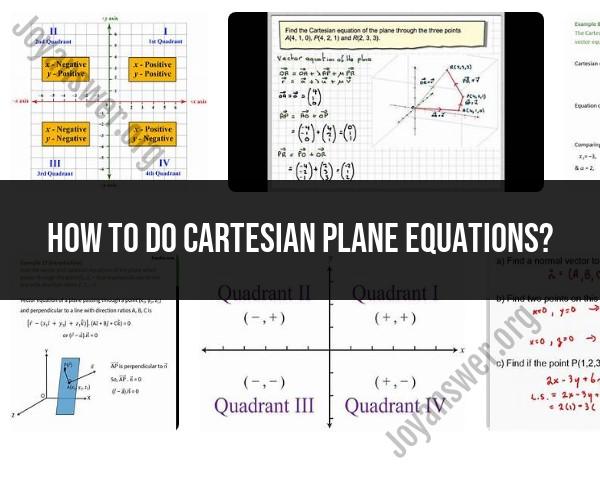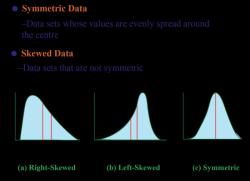How to do Cartesian plane equations?
Solving Cartesian plane equations involves working with the coordinates of points in a two-dimensional plane, typically represented as (x, y). These equations are used to describe lines, curves, and relationships between variables. Here's a step-by-step guide to solving Cartesian plane equations:
Understand the Equation Form:First, identify the form of the equation you're dealing with. Common forms include:
- Linear equations: In the form of y = mx + b, where "m" is the slope and "b" is the y-intercept.
- Quadratic equations: In the form of y = ax^2 + bx + c, where "a," "b," and "c" are coefficients.
- Circle equations: In the form of (x - h)^2 + (y - k)^2 = r^2, where (h, k) represents the center, and "r" is the radius.
Plot the Equation:For most Cartesian plane equations, it's helpful to visualize the graph of the equation by plotting points on the Cartesian plane. Plot at least a few points to understand the shape of the curve or line.
Solve for a Specific Point:If you need to find the value of "y" for a specific "x" value or vice versa, plug the given value into the equation and solve for the missing variable. For example, if you have y = 2x + 3 and want to find y when x = 4, you'd substitute x = 4 and solve for y: y = 2(4) + 3 = 11.
Find Intercepts:For linear equations, find the x- and y-intercepts. The x-intercept is where the line crosses the x-axis (y = 0), and the y-intercept is where it crosses the y-axis (x = 0). Set the other variable to zero and solve for the intercept value.
Determine Slope:For linear equations, determine the slope (m) by comparing the change in y (Δy) to the change in x (Δx) between two points on the line. The formula for slope is: m = (Δy) / (Δx).
Identify Special Characteristics:Look for any special characteristics of the equation, such as symmetry or asymptotes for curves, or the direction and steepness of a line. Understanding these features can help you interpret the graph and the equation.
Find Roots or Solutions:For quadratic equations (or any equation with unknown variables), you may need to find the roots or solutions. These are the values of "x" that make the equation equal to zero. You can use the quadratic formula or factoring to find these solutions.
Check for Restrictions:In some cases, there may be restrictions on the values of x and y that make the equation valid. For example, square root expressions must have non-negative radicands. Be aware of any domain or range restrictions.
Interpret the Graph:Analyze the graph of the equation to draw conclusions about the relationship it represents. For linear equations, the slope tells you about the rate of change. For quadratic equations, the vertex and direction of the parabola provide insights.
Verify Your Solution:After solving for specific values or roots, plug them back into the original equation to ensure they satisfy it.
Remember that practice is key to becoming proficient in solving Cartesian plane equations. Different types of equations may require specific techniques, so understanding the particular equation form is crucial for solving it accurately.
Cartesian Plane Equations: Mastering Graphical Representations
Cartesian plane equations are mathematical expressions that represent geometric shapes in the Cartesian plane. The Cartesian plane is a two-dimensional coordinate system that is used to graph and analyze geometric shapes.
Cartesian plane equations can be used to represent a wide variety of geometric shapes, including lines, circles, parabolas, ellipses, and hyperbolas. To master graphical representations using Cartesian plane equations, it is important to understand the following:
- The basic concepts of coordinate geometry, such as points, lines, and planes
- The different types of Cartesian plane equations
- How to graph Cartesian plane equations
Plotting Points and Equations on the Cartesian Plane
To plot a point on the Cartesian plane, we use its coordinates. The coordinates of a point are represented by an ordered pair of numbers, where the first number represents the horizontal distance of the point from the origin and the second number represents the vertical distance of the point from the origin.
To plot a Cartesian plane equation, we use the following steps:
- Solve the equation for one of the variables.
- Substitute different values for the other variable and solve for the first variable.
- Plot the points that we have solved for.
- Connect the points with a smooth line or curve.
Solving Problems with Cartesian Coordinates
Cartesian coordinates can be used to solve a wide variety of problems in geometry and algebra. For example, we can use Cartesian coordinates to:
- Find the distance between two points
- Find the slope of a line
- Find the equation of a line
- Find the intersection point of two lines
- Find the area of a triangle
- Find the volume of a rectangular prism
Navigating Geometry and Algebra in the Cartesian Plane
The Cartesian plane provides a common framework for navigating geometry and algebra. By understanding the relationship between Cartesian coordinates and geometric shapes, we can solve a wide variety of problems in both geometry and algebra.
Mathematics Made Visual with Cartesian Plane Equations
Cartesian plane equations can be used to make mathematics more visual. By graphing Cartesian plane equations, we can see how geometric shapes are related to each other and how they are affected by changes in the variables.
For example, we can graph the equation of a line to see how the slope of the line affects its steepness. We can also graph the equation of a circle to see how the radius of the circle affects its size.
Cartesian plane equations are a powerful tool for understanding and visualizing mathematics. By mastering graphical representations using Cartesian plane equations, we can gain a deeper understanding of geometry and algebra.












